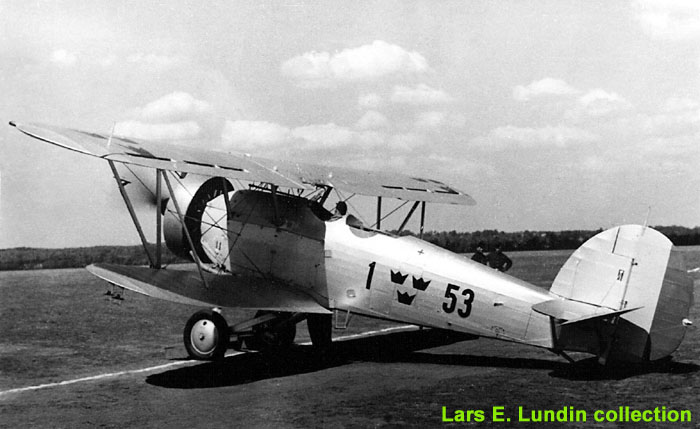|
|
||||||||
| B 4 - Hawker Hart (1934-1947) | ||||||||
|
|
Page 1 (of 2) |
|
||||||
|
|
||||||||
 |
||||||||
|
During
the evaluation, successful tests with the Harts as a dive-bomber were
executed. The Harts were re-designated B 4. A further 42 Harts were purchased from three manufacturers in
Sweden; twenty-one airframes from The Central Workshops of the Air Force
(CVM), eighteen airframes from AJSA at Linköping and three from Götaverken,
a major shipyard in Gothenburg, which just had started an aircraft
department. A total of 45 aircraft were supplied to the Air Force
1934-1939. The
three original British Harts (B 4)
were fitted with Bristol Mercury VII engines of 580 hp. All, except two,
of the Swedish manufactured aircraft were powered with the licence-built
NOHAB Mercury VIIA engine (580 hp) and designated B 4A. The remaining two Harts were provided with the Bristol Perseus
XI engine (755 hp). These aircraft got the designation B
4B. All Swedish Air Force Harts were equipped with ski landing gears
as an alternative to wheels. The
Harts were withdrawn as combat aircraft in 1940 and later used for
target towing, weather reconnaissance, liaison etc. Most of the aircraft
built made short careers as dive-bombers, but made an invaluable
contribution in developing the dive bombing technique, later refined
with the B 5 and B 17 aircraft. The
Swedish Harts were armed with one fixed and one moveable 7,9 mm
machine-gun. The aircraft were able to carry four 50 kg bombs or twelve
smaller bombs.
Five
Harts were transferred to the Swedish voluntary Wing F 19, which
operated in Finland during the Winter War 1939-40. Three of them were
lost during the service. The preserved B 4A on the photo above, displayed at Flygvapenmuseum, is painted and marked as the F 19 Harts. The blue
swastika was used by the Finnish Air Force since the early days and has
thus no connection with the German Luftwaffe.
C/n 52. Sw AF/n 714.
Photo
below: B 4 of Wing F 1 at Västerås.
Span
11,35 m. Length 8,56 m. MTOW 2.070 kg. Maximum speed 260 km/h. |
||||||||
|
For the Model Builder |
|
|||||||
|
|
||||||||
 |
||||||||
|
|
||||||||
|
|
||||||||
|
|
||||||||
|
|
||||||||
|
© Lars Henriksson |
|
Updated 2010-07-16 |
||||||

